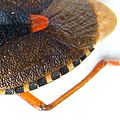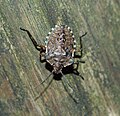Red-legged stink bug
| Red-legged stink bug | ||||||||||||
|---|---|---|---|---|---|---|---|---|---|---|---|---|

Red-legged stink bug ( Pentatoma rufipes ) |
||||||||||||
| Systematics | ||||||||||||
|
||||||||||||
| Scientific name | ||||||||||||
| Pentatoma rufipes | ||||||||||||
| ( Linnaeus , 1758) |
The red-legged stink bug ( Pentatoma rufipes ) belongs to the family of stink bugs (Pentatomidae). The epithet rufipes means "red-footed" or "red-legged" and refers to the red legs of the bug. It is one of the largest Central European bug species.
Features and way of life
The red-legged stink bug reaches body lengths between 12 and 15 millimeters. It is dark brown in autumn, lighter in summer, mostly bronze in color. The lateral edges of the pronotum are strongly curved upwards and run out into almost rectangularly angled lobes each with a pointed tooth. The tip of the scutellum is bright orange. The legs and the first segment of the antennae are usually reddish brown. The thin trunk ( rostrum ) is very long and reaches the rear edge of the 2nd abdominal segment. The larvae are dark, but become lighter, especially on the abdomen, with increasing age.
The animals feed on both vegetable and animal food. The animals suckle on buds, young shoots and ripening fruits. Eggs, larvae and pupae are also captured by insects or dead arthropods are sucked out.
After mating, the females lay the eggs on the upper side of the leaf. In contrast to other stink bugs, Pentatoma rufipes overwinters as a young larva in the 2nd larval stage under bark, in crevices or in moss, and not as a fully developed animal. The further development to the Imago takes place on deciduous trees.
Distribution and habitats
The species is regular and common and distributed throughout Europe to Asia Minor and Siberia . In the Alps, the species occurs up to approx. 1500 m altitude. The habitats of the red-legged stink bug include forest edges, parks and gardens. Here it lives on shrubs and on deciduous trees such as oaks , linden trees and maples, mostly in the treetops. They are less common on conifers. On fruit trees it can cause damage to the fruit if it occurs in large numbers. Sometimes they penetrate into the cities, where - attracted by light sources - they even fly into apartments.
photos
literature
- E. Security guard : watch bugs - get to know. Neumann-Neudamm, Melsungen, 1989, ISBN 3-7888-0554-4 .
- E. Wachmann, A. Melber and J. Deckert: Wanzen Volume 4 (Dahl, Die Tierwelt Deutschlands, Volume 81), Goecke and Evers, Keltern, 2008, pp. 153–157. ISBN 978-3-937783-36-9 .
- E. Wagner: Heteroptera Hemiptera. - In: Brohmer, P., P. Ehrmann & G. Ulmer (eds.): Die Tierwelt Mitteleuropas. IV, 3 (Xa). - Leipzig 1959, 173 pp.
Web links
- [1] Taxonomy (English)
- www.natur-in-nrw.de


